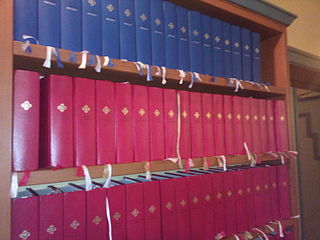Related Research Articles

Anders Hovden was a Norwegian Lutheran clergyman, hymnwriter poet and author.

Arnstein Rynning Arneberg was a Norwegian architect. He was active professionally for 50 years and is often considered the leading architect in Norway of his time.

Magnus Brostrup Landstad was a Norwegian parish priest and provost, hymn writer, and poet who published the first collection of authentic Norwegian traditional ballads in 1853.
Andreas Hauge was a Norwegian priest, educator, editor and hymn writer. He also served as a representative in the Norwegian Parliament.

Bernt Andreas Støylen was a Norwegian theologian, psalmist, and Bishop in the Church of Norway.
Peter Hognestad was a Norwegian Lutheran bishop, theologian, writer, and translator. Hognestad was from Jæren in Norway and he served as the Bishop of the Diocese of Bjørgvin from 1916 until his death in 1931.
Bernt Theodor Anker was a Norwegian linguist, priest and author. Anker was one of the first priests to use Nynorsk from the pulpit, and was a strong proponent of Nynorsk in the church and in society.

Sir Hans Paus was a Norwegian priest and poet. He was parish priest in Kviteseid from 1683 until his death. A popular man in his parish who learned the local dialect, he is noted for being the first to write poetry in dialect in Norway. His poem Stolt Anne, written in the Kviteseid dialect, became a popular folk song in Telemark. 12 verses were included in Norske Folkeviser (1853) by Magnus Brostrup Landstad and Henrik Ibsen, a relative of Hans Paus, paraphrased the poem in the drama Lady Inger of Ostrat. The poem honored Anne Clausdatter, the owner of Borgestad Manor and a relative of Paus. She rewarded him with an agricultural property (Bukkøy) for it. He owned several agricultural properties in Kviteseid.

Grefsen Church is a long church located in Grefsen, a neighborhood of Oslo, Norway.
Svein Ørnulf Ellingsen was a Norwegian visual artist and hymnist.
Norsk Salmebok, published in 1985, was the official hymnal of the Church of Norway from 1985 to 2013.
Nynorsk salmebok is a Nynorsk hymnal that was edited by Bernt Støylen, Peter Hognestad, and Anders Hovden, and first published in 1925. Under a royal resolution of December 18 that year, it was recognized for use in worship services and in country church parishes that adopted it. The hymnal originally contained 711 hymns, and under the royal resolution of October 1, 1926 it was decided to supplement it with 200 Bokmål additions from the old and new Landstad hymnal.

Gustav Margerth Jensen was a Norwegian priest, hymnologist, hymnwriter, seminary instructor, and liturgist. He is best known for his liturgy revision and hymnal publication.
Landstads kirkesalmebog, often simply known as Landstads salmebok, was the most important hymnal for the Church of Norway from 1870 to 1926.

Kingo's hymnal, officially titled Dend Forordnede Ny Kirke-Psalme-Bog, is a hymnal that was approved by royal decree for use in all churches in Denmark–Norway in 1699. The contains 86 hymns by the bishop of Odense, Thomas Kingo. It also bears Kingo's name on the title page because the selection was made based on a hymnal that Kingo had edited ten years earlier.

Psalmebog for Kirke og Hus, better known as Hauges Salmebok, was a Norwegian hymnal created by Andreas Hauge. On October 11, 1873, it was authorized for use in public worship in Norway by congregations that adopted it.

Nokre salmar was the first Nynorsk hymnal. It was published anonymously by Elias Blix. The volume was first issued as smaller booklets, with the first in 1869, and then in 1870 and 1875, and then in an expanded version in 1883 published by Det Norske Samlaget. On March 4, 1892 Nokre Salmar was authorized for use in public worship, and these Landsmål hymns were then incorporated into Landstad's hymnal as nos. 635 to 791.

Jens Frølich Tandberg was the bishop of Oslo from 1912 to 1922.

Guldberg's hymnal is a hymnal that was created by Bishop Ludvig Harboe and Ove Høegh-Guldberg and was authorized for use in 1778.

Norsk salmebok 2013: for kirke og hjem is the hymnal of the Church of Norway. It is published by Eide Forlag and was adopted for use on the first Sunday of Advent in 2013.
References
- ↑ Bolling, Reidar Olav Jonsson. 1951. Bernt Støylen. Oslo: Norske samlaget, p. 178.
- ↑ Dahl, Willy. 1981. Tid og tekst 1935-1972: med et sluttkapittel om tekstene i 70- og 80-årene. Oslo: Aschehoung, p. 315.
- ↑ Melsom, Odd. 1980. Fra kirke- og kulturkampen under okkupasjonen. Oslo: Institut for norsk okkupasjonshistorie, p. 99.
- ↑ Hamsun, Knut. 1994. Knut Hamsuns Brev, vol. 4. Oslo: Gyldendal, p. 92.
- ↑ Svendsen, H. Blom. 1955. Revision av Landstad og Nynorsk salmebok (= Bibliotheca Norvegiae sacrae, vol. 10). Bergen: A. S. Lund & Co., p. 73.
- ↑ Sudman, Arnulv. 1948. Norsk allkunnebok, vol. 6. Oslo: Fonna forlag, s.v. Jensen.
- ↑ Ringard, Morten. 1952. Byen under fjellet: Holmestrand, 1752 – 10. november – 1952. Oslo: Aschehoug, p. 79.